


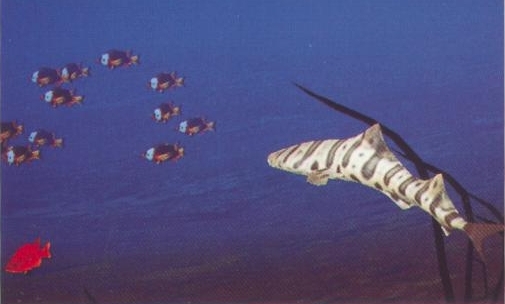
After having successively studied Molecules (See the Essay on The Chemical Bond), Crystals (See the Essay on Crystals) and Non-living Dissipative Structures (See the Essay on these dissipative structures), we are now well prepared to study the Living Dissipative Structures, these are the Organisms.
The point of view, like the other Essays, is a revised Substance-Accident Metaphysics which boils down to a Totality theory. Every individual organism is considered as an intrinsic uniform, but not necessarily homogeneous, thing or being. To account for this uniformity we must find a description in terms of their specific and individual Identities. The specific Identity is called its Essence. The individual Identity should be described in terms of a general universally valid Individuation Principle, and this is already done, namely in the Essay on The Principle of Individuation). In the present Essay we will concentrate on the Essence of an individual organism, i.e. the organic Essence insofar as organic Essence. Every individual organism will be interpreted as the product of some dynamical system (and this means a dissipative system, generating a dissipative structure ). The (ultimate) dynamical law, governing such a dynamic system, will be ontologically interpreted as the (above mentioned) Essence of the organism in question (For more about this orientation, see the Essay On Being and Essence, and the Essay on General Considerations).
A living being is an organized, material, inhomogeneous unity that maintains itself by its own actions. It exchanges energy and matter with the environment. It is a dissipative system or structure [ See for such structures the Essay on Non-living Dissipative Systems ], but because of its active self-maintenance it is a very special and sophisticated dissipative system. Its sophisticated activity is made possible by some large molecules that store the information to do so, information in the form of biochemical instructions (stored in those molecules). These molecules are able to copy themselves, by which it is possible to execute the encoded instructions at many different localities in the (multicellular) organism, and by which it is possible to pass on this information to its progeny. So a living being is ' matter with meaning '.
In virtue of their complex character especially higher organisms possess a whole series of morphological and functional levels, this in contrast with inorganic beings like crystals, which show only a few levels, and where genuine functionality is almost absent. Moreover Life is able to undergo evolution (evolutionary change) in the course of long successions of generations, i.e. to undergo changes in the course from progeny to progeny. These changes are (changes of) adaptations to the constantly changing environment. Organisms are 'historical' entities, in contrast with inorganic beings. Inorganic matter is only historical at its lowest level, for example with respect to the distribution of matter and antimatter in the Universe. Macroscopic inorganic entities, like crystals are not historical whatsoever. They are, to be sure, involved in time dependent processes, but this does not imply a gradual construction of ever more integrated and new Totality types. There is no mechanism of preservation and passing on of newly acquired properties and structures.
Every organism type is a special material design, generally not crafted from scratch but from some previous type, a design in order to cope with special challenges imposed on the organism by the outside world. An example of a very sophisticated design is the echo-location device in Bats. The phyletic development of adaptations often follows a whimsical course, filled with 'historical accidents' and is continually forced to further proceed from those structures already evolved earlier. That's why not every design is perfect in all respects (because they aren't designs after all!).
In the realm of Organisms the assessment of the individual can pose serious problems, like we can see in the Slime Mold and also in many colony-like individuals in lower organisms like Sponges. In higher organisms we finally find consciousness. This consciousness appears to be the seat of unity, and thus of being-a-Totality, but perhaps it isn't.
As has been said, organisms undergo an individual and a phyletic development. With that they continually interact functionally and non-functionally with the environment which itself changes all the time. But also the organisms themselves change the environment. The (relevant part of the) environment of organisms contains both abiotic and biotic factors with respect to mutual influencing. A complex interaction web is involved, consisting of a set of ecological relations and systems, without these ecosystems being clearly separated from each other (in fact there is but one global ecosystem on earth, with some of its parts closely connected, others loosely so). It is a flow of energy and matter going to and fro, of which the fundamental basis lies in the physical and chemical nature of matter (matter s.l., i.e. matter and energy).
Organisms come into a bewildering variety of forms, types and designs, some of which are displayed here.
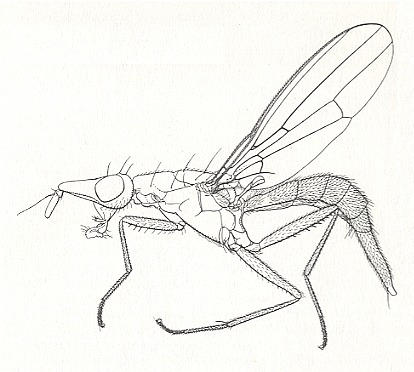
Ozaenina diversa, a fly of the family Otitidae. This family (better known, perhaps as Ortalidae) is related to the family Trypetidae. Larvae of Otitidae live, as far as is known, in decaying vegetable matter, or in dung .
After OLDROYD, 1964, The Natural History of Flies
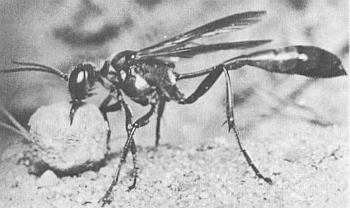
A female Ammophila pubescens [ a digger wasp ] returning to the nest with a pebble that she has selected to fit the bore of the burrow.
After EVANS & WEST EBERHARD, 1973, The Wasps
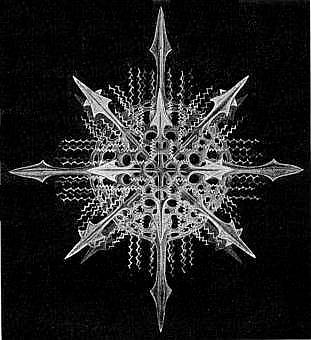
Lychnaspis miranda ( Radiolaria, Acantharia ) [ A unicellular marine animal with a mineral-skeleton ]
After HAECKEL, 1917, Kristallseelen
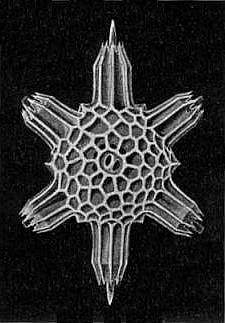
Hexacolpus nivalis ( Radiolaria, Acantharia ) [ A unicellular marine animal with a mineral skeleton ]
After HAECKEL, 1917, Kristallseelen
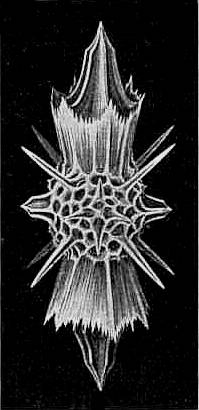
Diploconus hexaphyllus ( Radiolaria, Acantharia ) [ A unicellular marine animal with a mineral skeleton ]
After HAECKEL, 1917, Kristallseelen
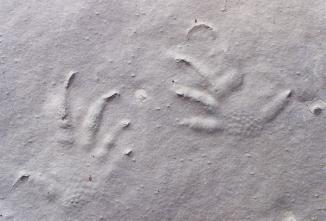
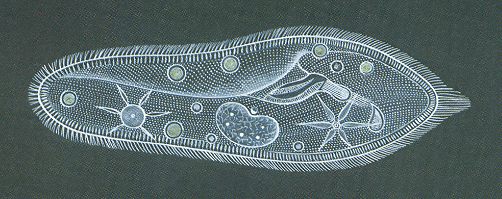
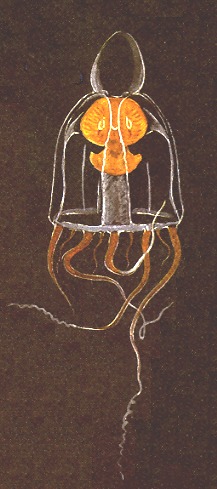
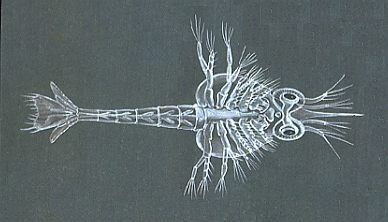
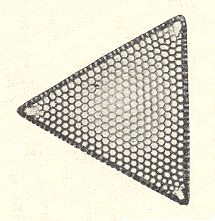
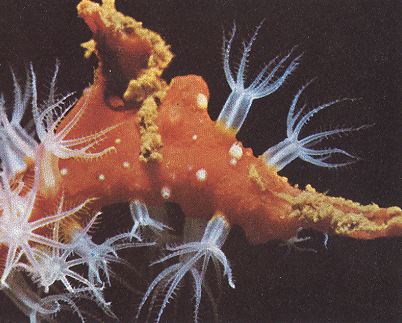
Probably more than two million species presently occur on Earth, and many others have lived in the past (which dates back to some 3 billion years).
In this Essay I want to discuss the nature of an organic Totality (only insofar as it is an organic Totality), i.e. (I want to give) a description of an actively self-sustaining entity in terms of a Substance, a Thing, having an Essence, which is the intrinsic cause of such a thing. Such a description will be in line with those concerning the other Totalities (Molecules, Crystals and Non-living Dissipative Structures). In line with these, because of the intended generality of the description.
A special consideration though will be devoted to man's self-awareness and the question whether this self-awareness points to his (individual) unity, or is (or is not) even the very cause of this unity.
But is DNA -- or, for that matter, DNA + all the molecules that participate in the DNA-controlling (mechanism) of the organism -- really interpretable as the dynamical law, governing the organism?
What is a dynamical law anyway?
A genuine, real, particular dynamical law is NOT a thing, not a concrete structure, not a concrete part. It is a principle. It is a principle of being, albeit a special principle of being (out of a whole set of such principles), not a general one. In the philosophy of Nicolai HARTMANN a particular dynamical law is a special (i.e. not a general) " category " of being, among all kinds of other special and general categories.
As such the law is a principle, while that something of which it is a principle, is the "concretum", and in the present context that is the particular organic dynamical system. A genuine dynamical law is homogeneously present in the dynamical system, and is homogeneously dispersed over (i.e. among) the elements of the dynamical system which it governs. Moreover this (organic) dynamical law is not wholly confined within the given organism, but is present in the whole dynamical system, which extends beyond the organism proper.
But DNA, and also the complete DNA-controlling mechanism (controlling the organism), is a concrete structure, it is a device, concretely present in the organism. It is a part of the organism, and does not extend beyond the organism proper. This part already belongs to the domain of the concretum, not to the domain of the principle. It is a produced (i.e. generated) structure, and it is produced by a law. It has been crafted in a very specific historical filtering context. So the DNA-controlling structure (controlling the organism) belongs to the phenotypic domain, while the real dynamical law belongs to the genotypic domain.
Remark: The expression " phenotypic domain " is here used in a metaphysical sense and must not be confused with the meaning it has within Genetics -- there the DNA forms the genotypic domain (See for its metaphysical use the Essay on The Determinations of a Substance, second section). The genotypic domain in a metaphysical sense is the domain of the ultimate dynamical law.
Moreover the DNA is not a statical entity but a dynamic one. The genes of one and the same genome, and consequently seated in one and the same body cell, can influence each others activity. And although we speak about a dynamical law, the law itself is not dynamic, it just governs dynamics. In itself the law is a static entity.
All this contributes to the conviction that the DNA of an organism cannot be interpreted as a ' dynamical law ' just like that. If we nevertheless want to do so, then it must be interpreted as a penultimate law.
But where then do we find the real dynamical law, the ultimate dynamical law?
In the case of the Totalities considered until now, Molecules, Crystals and Non-living Dissipative Structures, it is clear that in the relevant processes the atoms are never transformed into other atomic species. Their outer electron shells change it is true, but their atomic number (i.e. their nuclear charge = their number of protons) never changes, and this means that their specific identities never change (in the processes concerned). The atoms, involved in those processes (i.e. all the relevant chemism) form something like an ' inviolable level ' (See the Essay on Structural Levels (Critical Series of Essays), Section Dependent Levels and Inviolable Level). Exactly the same state of affairs we encounter in the case of all the processes that generate and maintain an organism. Also in this case the atoms stay what they were, they keep their specific identities unchanged, so also here they form the inviolable level. It is the atoms that are organized into living beings, and so it seems obvious that the dynamical law, governing the generation and maintenance of the organism, must somehow reside at this atomic level, at this inviolable level. And this law we can call the ultimate dynamical law with respect to the particular organism.
This state of affairs can be imagined as follows (See for the development of this particular point of view also the Essay on The Determinations of a Substance) :
The set of (individuals of certain) atomic species which take part, or have taken part, in the generation and maintenance of a certain (individual) organism contains the dynamical law for that organism. The numbers of individual atoms in this set are not fixed beyond a certain minimum. This set accordingly embodies the dynamical law in the following way : The law is based on certain properties of the diverse atoms, and so is inherent in this set in a dispersed way. It is not a concrete structure, but a principle. This law, so conceived, we will call the ultimate dynamical law, with respect to a particular organism. So this ultimate law does not inhere in the organism just like that, but (can be said to inhere in it ) only by referring back to the above defined set of atoms conceived as initially freely existing.
But with all this it would be wrong to imagine the generation of an organism starting with a mixture of individual freely existing atoms (of several atomic species), a mixture that would spontaneously organize itself all the way up into a living being. An individual organism does not develop this way, but from structures, i.e. molecules already very complex, the DNA molecules and its auxiliary molecules, which we encounter in the fertilized egg-cell. These complex molecules themselves are the result of a long supra-individual historical process. Once established they copied themselves and from time to time are transformed into variants. The instructions for building organisms were accordingly stored in these stable molecules, and thanks to this it was not necessary to preserve delicate structures and all kinds of (other) molecules which are normally produced in the organic processes. It looks a little bit like the transmission of a complicated picture through a telephone line by not transmitting the picture itself but only the algorithm (' recipe ') for generating it. Another advantage is that evolution does not need to begin from scratch every time, but can proceed forward from the already formed stable molecules, embodying the instructions, at hand. So when we speak about the ultimate set of atoms, containing the dynamical law for a certain organism, then we are not speaking about an actual dynamical system, not an actual process having occured somewhere, but a conceptual process, in order to assess the seat of the ultimate dynamical law for, i.e. the Essence of, that organism (And in this context of assessing the ontological seat of the Essence, this always means : for an organism-in-general). This seat is the mentioned inviolable level of the relevant atoms.
But it is clear that such a set of atoms is not at all specific. This implies that such a set must harbor a vast multitude of possible special dynamical laws, not only the one for that particular organism. It even also harbors many laws that could generate inorganic beings. One or the other special law only becomes effective when a whole series of successive specific conditions, creating a filtering context is going to be satisfied (Other special laws demand a different series). This series of conditions is stretching back beyond the individual organism that is actually generated from a fertilized egg, because the complex molecules already present in the egg, and representing already the blueprint of that particular organism, refer back to the initially free atoms and their relevant properties. Of course these atomic properties themselves refer back to yet more fundamental states, but the dynamical law (for a supra-atomic Totality), in the form of a principle, only emerges (together with a multitude of other special laws) when these properties themselves have emerged, and they emerge not until the relevant atoms (which are each for themselves a holistic entity) are formed. And when these atoms and their properties are formed the laws are there at once, but not in the form of concrete structures, but as immanent principles.
To retrieve the mentioned series of conditions is a task for evolutionary biology, not for metaphysics. The above mentioned penultimate dynamical law can be conceived to be seated in and around the organism's DNA in the form of the encoded instructions.
.